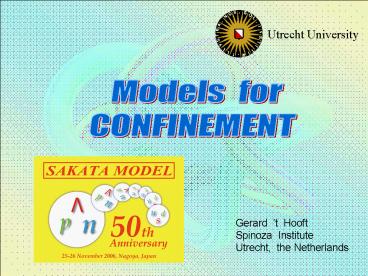Models for - PowerPoint PPT Presentation
1 / 20
Title:
Models for
Description:
... Infrared Renormalization The renormalized Coulomb potential ... we should start with a Fock space of Eigen states of particles bound by the potential V . – PowerPoint PPT presentation
Number of Views:69
Avg rating:3.0/5.0
Title: Models for
1
Utrecht University
Models for CONFINEMENT
Gerard t Hooft Spinoza Institute Utrecht,
the Netherlands
2
Contents
First part Absolute Quark Confinement in
lattice QCD Second part Absolute Quark
Confinement as a topological Phenomenon Third
part The Gluon Chain Model (Greensite,
Thorn) Try to do it better compare
Renormalization Procedure (infinite) Infrared
Renormalization The renormalized Coulomb
potential (in radiation gauge) Fourth
part Gauge invariant procedure Renormalized
effective actions an exercise in Legendre
Transformations
3
What kinds of forces were holding them
together?
4
The hadronic particles
Proton
Lambda
Antiproton
Pi-plus
Pi-zero
5
Part 1
Lattice QCD (K. Wilson, London, 1974)
6
Part 2 Magnetic Confinement
In case of spontaneous "breakdown" of
H.B. Nielsen and P. Olesen, 1970.
7
Color Magnetic Super Conductivity
S
N
Electric Super Conductor
Magnetic Super Conductor
8
The Magnetic Monopole
G. t H (1974), A.M. Polyakov (1974)
- Mandelstam (1975),
- G. t H (1976)
9
Part 3 The gluon chain approach
Anti- quark
quark
J. Greensite and C.B. Thorn hep-ph/0112326
?
then, improve Ansatz
10
This can be done better
The gluon chain model gives reasonable
looking "stringlike structures for the
mesons but confinement is not built in
The chainlike states will surely not form
a complete set of states. UNITARITY ?
Describe a "modified" perturbative
approach, where unitarity is guaranteed
Infinite infrared renormalization
11
Compare UV renormalization
Lowest order
Combine this with the higher order terms
12
Perturbative Confinement
13
Let V be a confining potential, typically
then
14
At lowest order, we should start with a
Fock space of Eigen states of particles
bound by the potential V . They are
confined from the very beginning
15
Part 4 A Classically Confining Theory
U ( D ) can become any monotonically
increasing function of D
16
Q
-Q
17
Legendre Transformations
18
The dual transformation
19
Quantum Chromodynamics is an extremely
accurate theory. At short distances, the
forces become weak, so that perturbative
treatment there is possible. Calculating
the QCD contributions to high-energy
scattering processes has become
routine. Interesting and important problems
remain - find a quark-gluon plasma - find
more accurately converging calculation
procedures ...
Utrecht University
20
Further References
Erice hep-th / 9812204 Montpellier
Proceedings (2002)
Nucl. Phys. B 138 (1978) 1 Nucl. Phys. B
153 (1979) 141 Nucl. Phys. B 190 (1981)
455 Acta Phys. Austriaca Suppl. XXII (1980) 531
Physics Reports 142 (1986) 6, 357
hep-th / 9903189
The End































